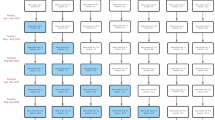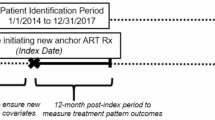Abstract
Background
The relationship of antiretroviral therapy (ART) adherence to total healthcare expenditures for Medicaid-insured people living with HIV or AIDS (PLWHA) is not well understood, especially among asymptomatic HIV-positive patients.
Objective
This study examined Medicaid-insured HIV-positive and AIDS-diagnosed patient groups to determine the association of ART adherence to mean monthly total healthcare expenditures in the 24-month measurement period, controlling for demographic, geographic, insurance, and clinical factors. The present study extends the existing literature by analyzing the relationship of ART adherence to total healthcare costs for asymptomatic HIV-positive patients separately from those patients with AIDS-defining conditions.
Methods
This retrospective study utilized claims data from Florida Medicaid claims from July 2006 through June 2011. All patients (n = 502) were HIV-positive, aged 18–64 years, non-pregnant, and ART naïve for at least 12 months prior to the measurement period. Each patient was categorized, based on medication possession ratios, as adherent (≥90 %) or non-adherent (<90 %), and were divided into two groups: HIV positive (n = 232) and AIDS diagnosed (n = 270). Generalized linear models predicted the mean monthly total expenditures for the non-adherence group versus the adherence group.
Results
For the HIV-positive group, the adjusted mean monthly expenditures for the non-adherent group were US$1,291; the adherent group adjusted mean monthly expenditures were US$1,926. The HIV-positive non-adherent group adjusted mean monthly expenditures were significantly less than the adherent group (−40 %, p < 0.001). However, for the AIDS-diagnosed group, there was not a statistically significant association of ART adherence to total healthcare expenditures (p = 0.29).
Conclusion
The results show that the relationship of ART adherence to healthcare costs is more complex than previously reported.
Similar content being viewed by others
References
Dieffenbach CW, Fauci AS. Thirty years of HIV and AIDS: future challenges and opportunities. Ann Intern Med. 2011;154:766.
Kitahata MM, Gange SJ, Abraham AG, Merriman B, Saag MS, Justice AC, Moore RD. Effect of early versus deferred antiretroviral therapy for HIV on survival. N Engl J Med. 2009;18:1815–26.
Reynolds SJ, Makumbi F, Nakigozi G, Kagaayi J, Gray RH, Wawer M, Quinn TC, Serwadda D. HIV-1 transmission among HIV-1 discordant couples before and after the introduction of antiretroviral therapy. AIDS. 2011;25:473–7.
Bozzette SA, Joyce G, McCaffrey DF, et al. Expenditures for the care of HIV-infected patients in the era of highly active antiretroviral therapy. N Engl J Med. 2001;344:817–23.
Nachega JB, Leisegang R, Bishai D, Nguyen H, Hislop M, Cleary S, Regensberg L, Maartens G. Association of antiretroviral therapy adherence and health care costs. Ann Intern Med. 2010;152:18–25.
Gardner EM, Maravi ME, Rietmeijer C, Davidson AJ, Burman WJ. The association of adherence to antiretroviral therapy with healthcare utilization and costs for medical care. Appl Health Econ Health Policy. 2008;6:145–55.
Acurcio FA, Puig-Junoy J, Bonolo PF, Braga Ceccato MG, Guimaraes MD. Análisis coste-efectividad de la adhesión inicial a la terapia antirretroviral entre individuos infectados por el VIH en Belo Horizonte, Brasil. Rev Espa Nola Salud Pública. 2006;80:41–54.
US Department of Health and Human Services. Guidelines for the use of antiretroviral agents in HIV-1-infected adults and adolescents. Bethesda: US Department of Health and Human Services; 2011. pp. 1–166.
Thompson MA, Aberg JA, Cahn P, Montaner JS, Rizzardini G, Telenti A, Schooley RT. Antiretroviral treatment of adult HIV infection 2010 recommendations of the International AIDS Society—USA Panel. JAMA. 2010;304:321–33.
McMahon D, DiNubile M, Meibohm A, Marino D, Robertson M. Efficacy, safety, and tolerability of long-term combination antiretroviral therapy in asymptomatic treatment-naïve adults with early HIV infection. HIV Clin Trials. 2007;8:269–81.
FDA. Approved and tentatively approved antiretrovirals in association with the President’s emergency plan. In: Presidential Emergency Plan for AIDS Relief (PEPFAR); 2011. http://www.fda.gov/InternationalPrograms/FDABeyondOurBordersForeignOffices/AsiaandAfrica/ucm119231.htm. Accessed 9 Sept 2011.
Hidalgo J. HIV/AIDS algorithm. Tallahassee: Florida Agency for Health Care Administration; 2009. http://ahca.myflorida.com/MCHQ/Managed_Health_Care/MHMO/docs/Templates/2009-2012-Templates/HIV-AIDS_Algorithm_Detail-03-06-09.xls. Accessed 7 Nov 2014.
Florida Statute. Reimbursement of Medicaid providers. Social and Economic Assistance 409.912(39)(a) (2008).
Public Health Service Act. § 340B, 42 U.S.C. (2013).
Smith SR, Rublein JC, Marcus C, Brock TP, Chesney MA. A medication self-management program to improve adherence to HIV therapy regimens. Patient Educ Couns. 2003;50:187–99.
Nachega JB, Hislop M, Dowdy DW, Lo M, Omer SB, Regensberg L, Chaisson RE, Maartens G. Adherence to highly active antiretroviral therapy assessed by pharmacy claims predicts survival in HIV-infected South African adults. J Acquir Immun Defic Syndr. 2006;43:78–84.
Mills EJ, Nachega JB, Buchan I, et al. Adherence to antiretroviral therapy in sub-Saharan Africa and North America: a meta-analysis. JAMA. 2006;296:679–90.
Steiner JF, Prochazka AV. The assessment of refill compliance using pharmacy records: methods, validity, and applications. J Clin Epidemiol. 1997;50:105–16.
Maggiolo F, Ravasio L, Ripamonti D, Gregis G, Quinzan G, Arici C, Airoldi M, Suter F. Similar adherence rates favor different virologic outcomes for patients treated with nonnucleoside analogues or protease inhibitors. Clin Infect Dis. 2005;40:158–63.
U.S. Census Bureau. U.S. Census Bureau, 2005–2009 American Community Survey. Washington, DC: U.S. Census Bureau; 2013.
U.S. Census Bureau. 2010 Census urban and rural classification. Census 2010 urban area criteria. http://www.census.gov/geo/reference/urban-rural.html. Accessed 2 Aug 2013.
Fakhraei SH, Kaelin JJ, Conviser R. Comorbidity-based payment methodology for Medicaid enrollees with HIV/AIDS. Health Care Financ Rev. 2001;23:53–68.
Manning WG, Basu A, Mullahy J. Generalized modeling approaches to risk adjustment of skewed outcomes data. J Health Econ. 2005;24(3):465–88.
Manning WG, Mullahy J. Estimating log models: to transform or not to transform? J Health Econ. 2001;20:461–94.
Short PF, Graefe DR, Schoen C. Churn, churn, churn: how instability of health insurance shapes America’s uninsured problem. New York: Commonwealth Fund; 2003.
Johnson MO, Dilworth SE, Taylor JM, Neilands TB. Improving coping skills for self-management of treatment side effects can reduce antiretroviral medication nonadherence among people living with HIV. Ann Behav Med. 2010;41:83–91.
Ammassari A, Murri A, Pezzotti P, Trotta MP, Ravasio L, De Longis P, Antinori A. Self-reported symptoms and medication side effects influence adherence to highly active antiretroviral therapy in persons with HIV infection. J Acquir Immune Defic Syndr. 2001;28:445–9.
Wohl DA, McComsey G, Tebas P, Brown TT, Glesby MJ, Reeds D, Wanke C. Current concepts in the diagnosis and management of metabolic complications of HIV infection and its therapy. Clin Infect Dis. 2006;43:645–53.
Rudorf DC. Adverse effects associated with antiretroviral therapy and potential management strategies. J Pharm Pract. 2005;18:258–77.
Hall AG, Harman JS, Zhang J. Lapses in Medicaid coverage: impact on cost and utilization among individuals with diabetes enrolled in Medicaid. Med Care. 2008;46:1219–25.
Harman JS, Hall AG, Zhang J. Changes in health care use and costs after a break in Medicaid coverage among persons with depression. Psychiatr Serv. 2007;58:49–54.
Acknowledgments
The contributions of John Large, Ph.D. and Sheri Eisert, Ph.D. on an earlier version of this paper are gratefully acknowledged. The authors had no conflicts of interest related to this paper, and had no funding for this research.
Author contribution
ZP developed the hypothesis. ZP, JR, BLO, and RB laid out the methodology for testing the hypothesis. ZP and JR provided statistical analysis. ZP developed the first draft of the manuscript. ZP, JR, BLO, and RB edited and revised the final draft of the manuscript. ZP is the guarantor for the overall content.
Author information
Authors and Affiliations
Corresponding author
Additional information
Robert G. Brooks was formerly affiliated with the University of South Florida, Morsani College of Medicine and College of Public Health, Health Policy and Management, Tampa, FL, USA.
Appendix
Appendix
Rights and permissions
About this article
Cite this article
Pruitt, Z., Robst, J., Langland-Orban, B. et al. Healthcare Costs Associated with Antiretroviral Adherence Among Medicaid Patients. Appl Health Econ Health Policy 13, 69–80 (2015). https://doi.org/10.1007/s40258-014-0138-1
Published:
Issue Date:
DOI: https://doi.org/10.1007/s40258-014-0138-1




